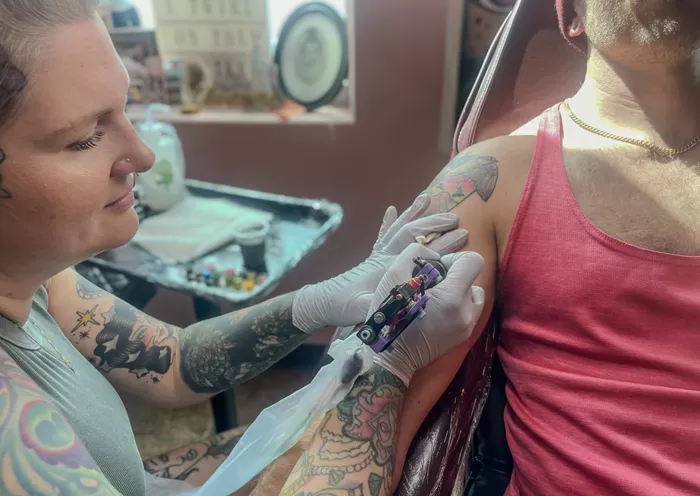In a field once dominated by men, women tattoo artists in Anchorage are increasingly reshaping the local industry, offering clients not only high-quality ink but also a sense of belonging, identity, and emotional safety.
On a recent Friday, Laura Craver carefully blended blue and green ink into an elaborate tattoo that tells the story of her client Alex Johnson’s 20-year relationship with his husband. The design, which spans most of Johnson’s upper arm, includes deeply personal scenes — the sequoia tree where the couple married, the place they first met, and their paddling trip along the Yukon River. It’s a project years in the making.
“It’s a very vulnerable act to get a tattoo,” said Johnson. “To do it with someone who makes you feel comfortable, safe, and beautiful — that’s an incredible gift.”
Johnson’s connection with Craver highlights a broader shift in Anchorage’s tattoo scene, where women artists are increasingly at the forefront. While male-owned studios once dominated the city, today, female tattooers are gaining visibility, attracting clients drawn to the inclusive and welcoming environments they foster.
Although the Alaska Board of Barbers and Hairdressers does not track tattoo artists by gender, many in the industry agree that the number of women-owned and operated studios is on the rise.
Craver, a tattooist with more than a decade of experience, opened Brightside Tattoo in 2022 with the goal of creating a studio that felt different from the traditional mold — a place where clients of all identities could feel safe and seen.
“All we want to do is make people happy,” said Craver. “Everyone who walks through our doors is excited to be here, and we want to give them a really fun and comfortable experience.”
Brightside Tattoo, with its baby pink walls adorned in tattoo flash, Alaska Native artwork, and framed insect specimens, is staffed by four artists who are encouraged to bring their identities into their art. Craver said the studio prioritizes hiring women, BIPOC, and queer artists — individuals who often face additional challenges in a historically male-dominated industry.
“Many of our clients specifically seek out women, queer artists, or artists of color,” Craver said. “They gravitate to our space because they know they’ll be represented.”
That commitment to inclusivity is echoed at The Coven, another Anchorage studio founded by artist Elizabeth Gittlein in 2019. Her goal was to create a relaxed, client-focused environment.
“People can walk into this space and know it’s about them,” said Gittlein. “These four walls can be anything they need them to be. I’m just the facilitator.”
Gittlein’s work centers on nature and life cycles — mushrooms are a frequent motif — and many of her tattoos are placed on intimate parts of the body, which she says can empower clients and help them embrace their bodies. Most of her clientele are mothers and queer individuals who often grant her full creative freedom.
“That kind of collaboration — where someone brings me a story and a canvas, and I turn that into wearable art — is the dream,” she said.
The Coven also hosts community events, including flash tattoo days for Friday the 13th and Pride Month, as well as walk-in days at the end of June.
Industry veteran Debra Yarian, who co-owns Eagle River Tattoo with her husband, Don, recalls a time when tattoos on women — let alone by women — were seen as taboo. Since opening her shop in 2008, she’s witnessed a sea change in public perception.
“When I started almost 50 years ago, women getting tattooed was considered immoral,” said Yarian. “Now, everyone is tattooed. Society’s perception has changed dramatically.”
Indeed, data from National Geographic and the Pew Research Center show that the number of Americans with tattoos has more than doubled in the past 25 years.
The rise in female tattoo artists extends beyond machine tattooing. Holly Mititquq Nordlum, an Inuit artist from Kotzebue, has played a key role in reviving traditional hand-poked and hand-stitched tattooing practices in Alaska. When she began a decade ago, female traditional tattooers were nearly nonexistent in the state.
“I couldn’t find anything that reflected the traditional model — women tattooing women,” Nordlum said. “That just wasn’t happening here at the time.”
Today, she estimates there are eight Inuit tattooers — mostly women — working across Alaska, from Anchorage to Utqiagvik. Her clients are predominantly women, and she particularly cherishes tattooing across generations of the same family: grandmothers, mothers, and daughters.
Many of her clients wrestle with questions of cultural identity, she said.
“About 80% of the girls who come in wonder if they’re Inuit enough or Native enough to wear the markings,” she explained. “Colonization has left them feeling like they’re not enough. That’s where the real magic happens.”
Back at Eagle River Tattoo, Yarian said the Anchorage tattoo community has become more inclusive over time — a shift she embraces wholeheartedly.
“Fortunately, many studios here are now safe spaces for all people,” she said. “It’s important to build relationships with clients, to ensure they feel comfortable and safe.”
As more women lead studios and bring diverse perspectives to the art form, Anchorage’s tattoo scene continues to evolve — becoming not just more expressive, but more welcoming.
Related topics:

